AMD Radeon HD 7750 & Radeon HD 7770 GHz Edition Review: Evading The Price/Performance Curve
by Ryan Smith & Ganesh T S on February 15, 2012 12:01 AM EST- Posted in
- GPUs
- AMD
- HTPC
- GCN
- Radeon HD 7000
Power, Temperature, & Noise
As always, we wrap up our look at a new video card with a look at the physical performance attributes: power consumption, temperatures, and noise.
While it’s the second sub-series of the 7000 series, the 7700 series is actually first in a number of ways for AMD. It’s the first midrange series to feature PowerTune since its introduction in 2010, and it’s the first time the 28nm process has been used on such low power cards. As such the power, temperature, and noise characteristics of the 7700 series are virtually a blank slate waiting to be filled.
| Radeon HD 7700 Series Voltages | ||||
| Ref 7750 Load | Ref 7770 Load | XFX R7770 BESDD | ||
| 1.1v | 1.2v | 1.2v | ||
The idle voltage for all 3 of our 7700 series cards was 0.825v. Meanwhile the load voltage for our 7750 was 1.1v, while it was 1.2v for both the reference 7770 and the XFX BESDD.
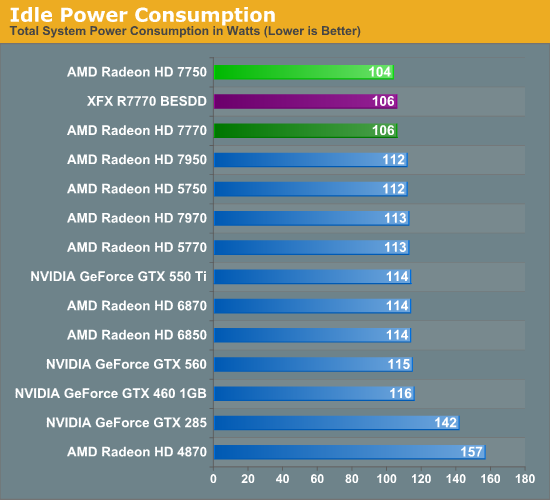
AMD’s official idle power consumption figure is <10W for both the 7750 and 7750. In practice we find that there’s a 2W difference between the two cards, with the 7750 coming in at 104W at the wall and the 7770 at 106W. AMD’s continuing efforts to reduce idle power consumption are clearly paying off, making this the lowest idle power usage figures we’ve recorded yet.
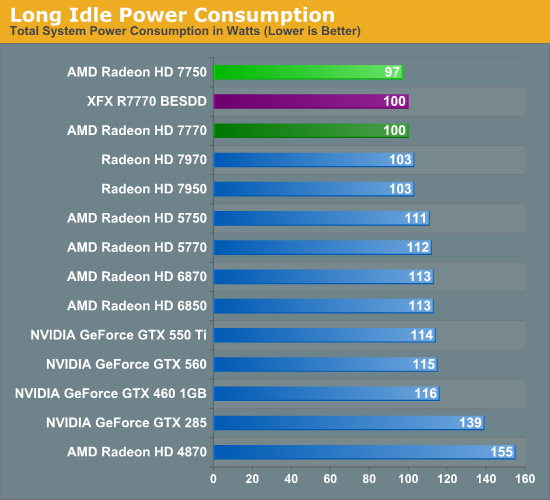
Meanwhile under the so-called “long idle” scenario with a blank monitor, the 7000 series continues to cement its lead. Officially all Southern Islands cards have a long idle power consumption level of <3W since they should all be using the same PCIe controller to keep a heartbeat going, however we’re finding there is a difference, even between the 7750 and 7770. The 7770 consumes 3W less than the 7900 series, meanwhile the 7750W consumes another 3W less, bringing it down to 97W. Since our readings are from the wall it’s tough to gage just how much these cards are still using, but at this point there doesn’t seem to be much farther to drop.
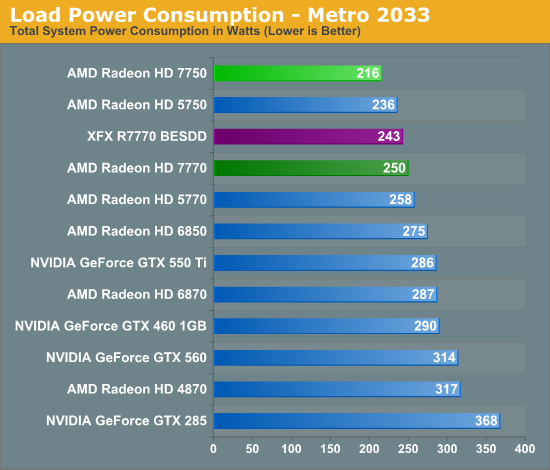
When we talk about the 7700 series bluring the line between what we’d expect out of an AMD 700 series card and an AMD 600 series card, results like this are part of the reason why. With a 75W PowerTune limit the 7750 has the lowest power consumption of any of the cards in our lineup, beating even the 5750. The 7750 is clearly in a league of its own, with only the 7770 drawing similar amounts of power as the 5700 series.
To that extent, it’s interesting to note that the XFX BESDD consumes less power than the reference 7770, in spite of its factory overclock. XFX did not increase the voltage of the card, but we’d still expect power consumption to go up at least a bit, not come down. In any case even with its 10% better performance, it’s consuming 7W less than the reference 7770 here. Otherwise at 250W the 7770 is pulling 8W less than the 5770 and 25W less than the 6850 from the wall, succinctly showcasing the power benefits of TSMC’s 28nm process.
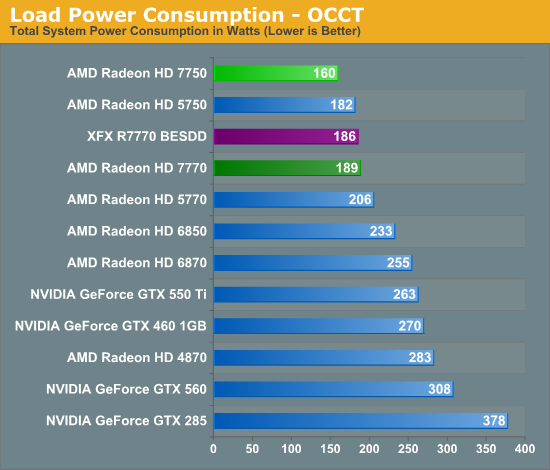
Our results with OCCT largely mirror Metro, with the 7750 in a class of its own while the 7770 consumes less power than anything other than the 5750. Since this is our pathological test, the lack of PowerTune plays a big part here, as PowerTune keeps the 7770 capped at 100W while the 5770 and 6850 are free to go well over their TDPs.
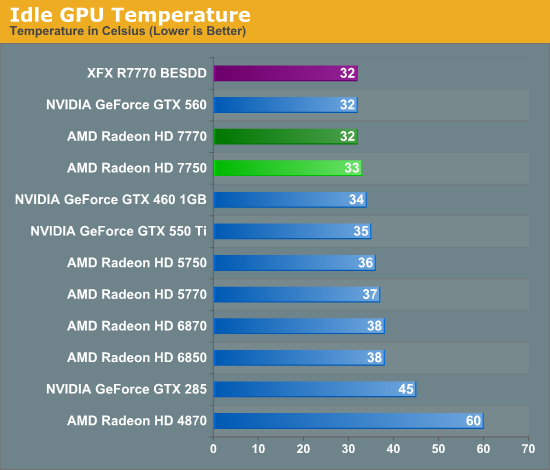
There’s little to say about idle temperatures that hasn’t been said before. With a half-decent cooler, almost any card can reach the mid-to-low 30s. The 7700 series is no exception.
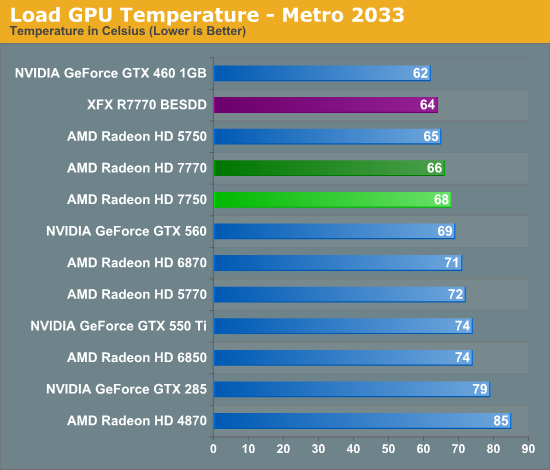
Moving on to Metro, our results are largely consistent with what we’d expect given our earlier power data. Even with the lower power consumption of the 7700 series AMD can’t quite beat the GTX 460 1GB, otherwise with temperatures in the mid to upper 60s the 7700 series looks quite good. XFX’s BESDD looks especially good thanks to the fact that it’s an open air cooler, as it only reaches 64C.

As with OCCT power consumption, OCCT temperatures are largely a story of PowerTune or the lack thereof. With PowerTune clamping down on power consumption, temperatures never rise by too much. At 71C the reference 7770 is still doing well, while XFX’s card does even better.
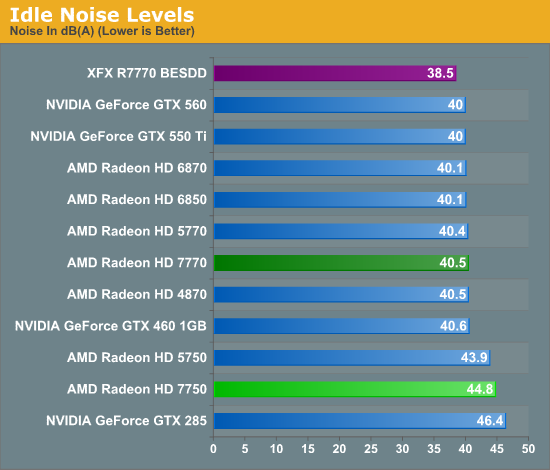
Based on our power and temperature data, our noise data came at somewhat of a disappointment. The 7750 has a small fan with an idle fanspeed of 39%, leading to it being quite loud relative to its competitors. Thankfully none of AMD’s partners will be using that specific cooler, so we wouldn’t expect any retail cards to be this bad. Though if silence is key, Sapphire’s passively cooled 7750 is always an option.
As for our 7770 cards there aren’t any surprises. The open air cooled XFX BESDD does the best, though at only 40.5dB the reference 7770 is doing almost as well on its own.
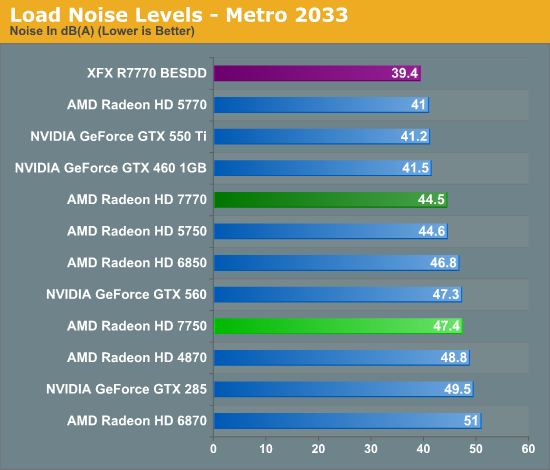
I had to rerun Metro a few times just to make sure our XFX BESDD numbers are right; and they were. XFX’s open air cooler combined with the 100W board limit of the 7770 means that there’s relatively little heat to dissipate, which the open air cooler does extremely well. While this isn’t technically silent it’s damn close.
Elsewhere the reference 7770 does decently, but its half blower nature hurts it when it comes to noise. The noisy 7750 only gets louder, unfortunately.
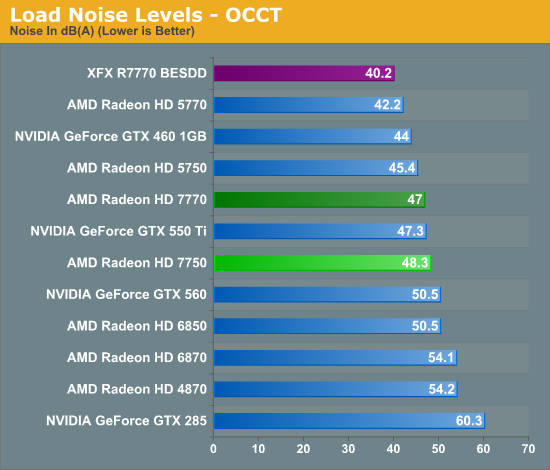
Finally, noise under OCCT is nearly the same story. The XFX BESDD finally goes above 40dB, a testament to the capabilities of XFX’s open air cooler. As for the AMD cards, there’s really not a great deal positive to say as even a traditional blower shouldn’t be quite as bad as what we’re seeing with the reference 7770. Perhaps it’s for the best that none of AMD’s partners are using their reference designs.










155 Comments
View All Comments
mattgmann - Wednesday, February 15, 2012 - link
Don't forget, when the 4870 pricing was low, at the end of 2008, BOTH AMD and Nvidia were settling price fixing lawsuits. These companies have cheated before; they'll do it again.Hubb1e - Wednesday, February 15, 2012 - link
"Recessions are good for the rich... not so good for everyone else. "Really? So when the stock market lost 40% of its value and the rich lost 40% of their net worth, that was good for them?
The rich can ride out a recession better than the poor because they don't live paycheck to paycheck, but it sure as hell wasn't good for them.
Galidou - Sunday, February 19, 2012 - link
Maybe we can see 4870's with maximum performance/die size in mind pricing failure because it was performing close to the big die from Nvidia gtx2xx. Or maybe we can see the ''double performance from last gen'' tactic from Nvidia a fail when it means building a super big die with low performance/size ratio just to get that double performance motto... It was all a question of ''goal to attain'' from each company. One goal paid off more than the other that time.From an Nvidia's fanboy perception, the first will be true and the second unthinkable. From an ATI fanboy, the first will make no sense and the second will suit them well. From someone with no choosen side, both can be true.
But these 7770 and 7750 here, makes no sense, such small die with such performance for that price.....
Malih - Wednesday, February 15, 2012 - link
I agree, smells fishy, usually at this point nVidia would lower their card price.The latest price competitive part from AMD is the 6800 series. Probably have to wait for the 8800 series?
Kjella - Wednesday, February 15, 2012 - link
I know, I bought a 5850 before the MSRP hike for around $279 + VAT in 2009 and I just checked, it clearly beats a 7770 so a >$159 value today, maybe close to the $200 card being launched in March. The 6xxxx series I thought was just because they had to scrap the 34nm process and deliver essentially a refined 5xxx series, but now they're on 28nm and there's not much bang for the buck for those of us that already have a gaming card from the 4/5xxxx series. I hope this is just a temporary situation until nVidia gets their Kepler out, or I might just sit out another generation...eminus - Wednesday, February 15, 2012 - link
AMD has AMD (Accute Money Deficiency) right now so they need every penny they can gain.Cygni - Wednesday, February 15, 2012 - link
It seriously seems that the 4850/4870 was an incredible purchase. In 2009, you could get a 4850 for $99 dollars. And it STILL holds up to the top range cards.I mean we all know that Nvidia and AMD are playing the profit game 10 times harder than the performance game in this sector, simply because games can't press the limits of the hardware, but it's still impressive.
just4U - Wednesday, February 15, 2012 - link
I bought 4 cards in the 4x lineup..First a 4850 for $170, Second a 4870 for $199 Third a 4870 1G for $229 and lastly a 4830 for 140.. While I live in Canada I don't think prices ever came that low unless you got one helluva good deal.. $99 pricing for the 4850 wasn't the norm even late in its production run.
BPB - Wednesday, February 15, 2012 - link
I got mine real chaep at launch! BestBuy mispriced them. Still, not too much later there were good deals again and I got one for my daughter's desktop. These cards in CF still hold up well for 1920x1200 gaming. I would like to upgrade to better performance and lower power, but AMD is making that hard dollar-wise.Jorgisven - Wednesday, February 15, 2012 - link
Indeed. Best Buy had a 25% off all Visiontek cards the week of the 4850 launch, so I got mine at launch for $150. I then caught an amazing deal on a 4870 a few months later ($129 shipped), sold my 4850 for $140. I basically bought both for a net $140.I've been waiting for a good AMD card, but just haven't seen one. I've been tempted by the 560 Ti or 570, but they're still too expensive for my taste, and don't offer enough of an advantage to spend the cost of a PS3 on upgrading from an already decent GPU.
I'm rather disappointed with Red as of late.